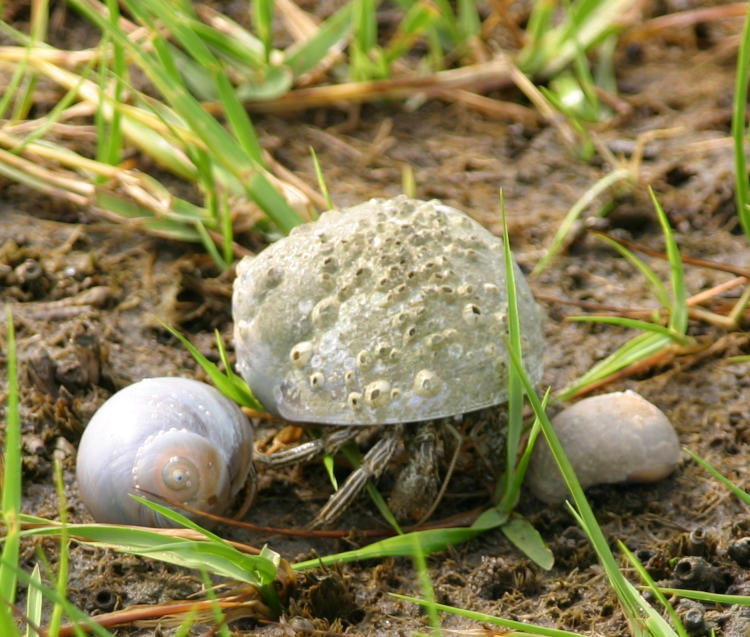
N 33°57’37.10″ W 77°56’31.87″ Google Earth location
The best time to see something like this is early morning, and it should be clear that the barnacle-encrusted shell in the middle is housing a hermit crab – they all are, actually, and they typically forage at night to early morning in the beach grasses immediately adjacent to the waterline. I’ve only ever been there in summer though, so I can’t say for sure whether you can see them in other seasons, but I don’t think they hibernate – colder weather might just make them remain in deeper water or something. I don’t have a resource to identify hermit crabs, but looking at those legs, I’d be inclined to say these are thinstripe hermit crabs (Clibanarius vittatus,) which seem to be very common on the Atlantic seaboard. They’re aquatic, but as long as they keep some water within their shells to moisten their gills, they can forage on land for a while. This was right at the mouth of the Cape Fear River where it drained into the Atlantic Ocean, so brackish water – I’ve found shrimp several kilometers further upriver.
A little trick: if you see any shell of this approximate shape (typically whelks or conchs,) on land or under the water’s surface, and the opening is facing down, it’s probably occupied – the weight is opposite the opening so empty shells will usually be turned upwards by wave action. Even if the crab gets overturned, it knows that facing down is ideal and won’t waste any time righting itself when it feels that it’s safe to do so. Depending on the size of the occupant, when withdrawn the legs may be way up inside, almost entirely out of sight, so never assume such shells are empty if you’re collecting them.
They will usually withdraw when they sense danger, but within a minute or two, if things remain quiet, they’ll emerge only partially, observing the surroundings for a short while, before they fully extend their legs and get back to business. I waited out a couple of the larger ones to see what they did, and watched as one trundled right over to the ‘cliff’ (not half a meter tall, but impressive to these guys) where the turf had broken away from wave action, and without hesitation plunged over. The shell clattered and rolled across where the soil gave way to the beach sand, then sat motionless for a couple of minutes before the occupant re-emerged and continued on its journey; it had withdrawn in a split second as the shell toppled over the edge and apparently such knocks don’t have any serious affect.
The number of crabs on the beach that morning (thirteen years ago) was staggering – the grasses were literally crawling with them, and I endeavored to do a wider shot to show this, but the grasses were a little too thick and the crabs too small (ranging from 1-4 cm,) so all that really showed were paler blobs that could have been rocks or chewing gum or anything. Video would have worked better, but I didn’t have the ability at the time, and not the time on subsequent returns. Maybe next year.




















































